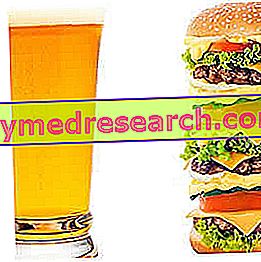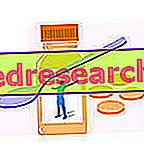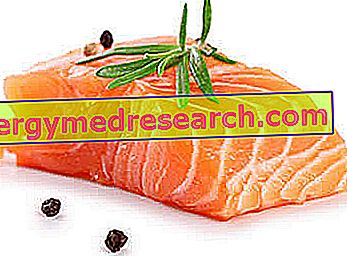The topic Diet and Hepatitis is really very vast! First of all, it is necessary to explain what hepatitis is (to dispel myths and false beliefs); after which we will analyze how it is possible to contract hepatitis through diet; finally, we will see how to prevent it and structure a correct diet as a support to care.

Hepatitis: What Does It Mean?
The term hepatitis indicates inflammation of the liver.
The liver is an organ with glandular function located in the upper abdominal cavity (right hypochondrium and epigastrium), between the stomach and the transverse colon.
The liver performs many functions, such as glycemic support (essential for the brain), the synthesis of plasma proteins (of different types, which also aim to maintain oncotic pressure) and the metabolization of toxic substances and drugs. Obviously, in conditions of hepatitis the liver is not able to perform its tasks with normal effectiveness and efficiency, even if the severity of the disorder depends on many factors, for example: etiopathological causes, age of the subject, treatment, complications, comorbidities, etc. . Sometimes, due to hepatitis, there is also an anatomical and histological alteration of the liver.
The causes of hepatitis include: alcoholism, abuse or adverse drug reactions, ingestion of poisons, fungal toxins, viral infections, bacterial infections, parasitic infestations, iron overload, autoimmunity etc. They can be acute or chronic and, of all, the only ones to be contagious are the infectious forms, therefore induced by pathogenic agents (generally viral).
The complications of hepatitis can be significantly different depending on the causes of the disease, although, more than anything else, they vary according to the severity of the hepatitis. In the most serious cases, there is an alteration of the cyto-histological tissue component typical of fibrosis; worsening, in some cases fibrosis can develop into cirrhosis, with hepatic failure and increased risk of malignancy.
Contract Hepatitis with Diet
DIET can be a primary cause of hepatitis. Among all the various forms, foodborne hepatitis can be divided into infectious (and infestation), and non-infectious.
The infectious diseases are essentially of the following type: viral ( HAV virus for hepatitis A), bacterial ( Salmonella typhi for typhoid fever, Leptospire for leptospirosis) and parasitic ( Entamoeba histolytica or Entamoeba dispar for hepatic amebiasis, generally secondary to intestinal entry).
The hepatitis contracted with the diet that does not depend on infectious agents are basically you: alcoholic steatohepatitis (alcoholic steatohepatitis), steatohepatitis due to indiscriminate food abuse (especially of carbohydrates and fats - food steatohepatitis) and mycotoxin intoxication (Falloidea syndrome, from certain types of Amanita or Lepiota, and intoxication with aflatoxins from Aspergillus flavus ).
We exclude instead the hepatitis caused by chemical agents and drugs which, although passing through the digestive tract, are not contracted in order to feed.
NB . Also some algal toxins, or those of Cyanobacteria ( Cyanobacteria, once called blue algae) have hepatotoxic capacity but, due to their modest epidemiological importance, they will not be treated in the following paragraphs.
Of all the mentioned, the contagious forms, of viral, bacterial and parasitic type, are transmitted above all through ORO-FECAL contamination, that is by ingesting food or water contaminated by the responsible agent.
Viral hepatitis with diet
This form of hepatitis is contracted through the consumption of raw water or RAW foods containing the HAV virus. Like all viruses, this is also thermolabile and can be destroyed by cooking food or boiling water. The foods typically involved in the spread of food viral hepatitis are raw molluscs, especially bivalves and gastropods; vegetables and fruit with raw peel are less frequent. Cases of hepatitis A caused by the ingestion of torrential water or pozz are not lacking, since, even in the cases already mentioned, the virus is often present suspended in water (from the sea for the molluscs or from internal irrigation courses). Obviously, the possibility that the virus is present at high concentrations in the water increases exponentially in the presence of abusive sewage discharges; this is true both for those entering the freshwater streams or at sea, and for those on land that contaminate the underground aquifers.
Last but not least, the sources of direct viral diffusion for: manipulation of an infected and hygienically incorrect operator, incorrect slaughter, cross contamination, contamination by insects and small animals (eg flies that transfer the virus from faeces to food). Hepatitis A has an acute course and often heals spontaneously in a couple of months.
Bacterial hepatitis with diet
This form of hepatitis is secondary to the infection of Salmonella typhi or of species belonging to the genus Leptospira .
Unlike salmonellosis, typhoid fever is systemic as bacteria pass through the intestinal mucosa without damaging it to enter the circulation; it affects many organs, including the liver, although it does not always give rise to true hepatitis. The conditions of expansion and diffusion of the bacterium Salmonella typhi are the same as those of virus A, or the fecal-gold contamination of water and / or food. Furthermore, the bacterium is thermolabile and should perish at about 60 ° C. Typhoid fever has a tendency to be acute and rarely chronic. The cure is made up of antibiotics.
Leptospirosis is a zoonosis, or a disease transmitted by animals (mammals, birds and reptiles) to humans. There are different types, diffused respectively by different organisms. Leptospirosis is systemic and presents different forms of diffusion; in addition to faecal gold, leptospires can be excreted in urine and saliva. Ultimately, it is possible to contract leptospirosis both with faeces, but also with saliva and the urine of animals (such as pigeons and rats) that come into contact with food. Also in this case slaughtering is a process extremely affected by the spread of the pathogen. The severity of the related hepatitis depends on the Species and the strain in question, but also on the availability of antibiotics (barely present in the most widespread areas, ie the third world); it too has a tendency to be acute and rarely chronic. The resulting hepatitis seems to be caused by edema of the hepatic capillaries that causes cellular necrosis.
Parasitic hepatitis with diet
An example of this disease is the contraction of amoebiasis. Even in this case, the Entamoeba histolytica or the Entamoeba dispar are already present in the waters and, from here, they can end up on food (either directly or by fecal-oral route). This organism easily perishes with the use of heat and its presence in food at the time of consumption is permitted by the rawness of the food or by post-cooking contamination. The therapy consists of amebicidal drugs; once again the course tends to be acute but it can become chronic, even primarily. Very often, the amoebae reach the liver only after having affected the intestine.
Fatty, alcoholic and alimentary steatohepatitis
Steatohepatitis is characterized by an increase in the volume of the liver due to an increase in lipid storage and, to a lesser extent, of glycogen in it. In practice, the liver accumulates an excess of fat, so it thickens and becomes inflamed. This is mainly due to the immoderate increase in blood sugar and triglycerides in the blood, in turn induced by the abuse of ethyl alcohol (always converted into fatty acids by the liver) and / or by a generally too abundant diet with the intake of excessive portions of high carbohydrate foods. Lipid excess also appears to be involved in the onset of fatty steatohepatitis, but mainly in diets characterized by high frequency of consumption of junk foods (in which lipids are saturated, hydrogenated and with high percentages of fatty acids in trans configuration) . In any case, the fundamental requirement for the onset of fatty steatohepatitis is ALWAYS THE CALORIC and / or ALCOHOLIC ESUBERO!
Typically, this form of hepatitis is diagnosed during check-ups, perhaps following the detection of altered blood parameters (transaminases, triglycerides, blood sugar, cholesterol) or the manifestation of discomfort, swelling or pain in the abdominal area of the right hypochondrium. Food is often associated with overweight (mainly visceral), insulin resistance, hypertriglyceridemia or, more generally, metabolic syndrome. In the long term and if neglected it can evolve into very serious conditions; unfortunately, the one with a purely alimentary etiology seems more subtle than alcohol, as it is almost ALWAYS asymptomatic. Usually, after the diagnosis, to obtain a fairly rapid remission it is sufficient to abolish alcohol, use specific prescription drugs, start a balanced low-calorie diet, increase physical activity and, possibly, consume food supplements aimed at improving liver health. As can be presumed, it is a tendentially chronic pathological form even if, in certain cases of alcohol abuse, real manifestations of acute occur.
Mycotoxin hepatitis with diet
Mycotoxins are toxins released by organisms belonging to the kingdom of fungi; in the case of hepatitis, the fungi belonging to the Basidiomycota Division and those of the Phylum Ascomycota are mainly involved. The former are voluntarily taken with the diet, mistaken for edible mushrooms; the latter, instead, some of which are completely undesirable, are better known as molds.
The mycotoxins most harmful to the liver, able to originate a Falloidea Syndrome Hepatitis, belong to some Species of the Genera Amanita and Lepiota . These mushrooms, if taken with the diet, are able to poison the organism in a rather long period, which almost always determines the inability to intervene at (late) diagnosis. The phalloid syndrome is one of the leading causes of death worldwide and, already at the third of the four clinical phases, causes a violent increase in hepatic markers due to hepatocyte destruction. If from that moment the intoxication does not undergo a rapid inversion, it evolves into the fourth phase and causes (from the initial hepatitis) a severe hepatic insufficiency followed by death. The treatment may consist of: gastric lavage, administration of activated charcoal capable of absorbing poisonous molecules, forced diuresis, hemodialysis, plasmapheresis and drugs. This is an acute course and often requires liver transplantation.
Less lethal, but still dangerous, are the mycotoxins belonging to the aflatoxin type produced by the mycete Aspergillus flavus . These microorganisms, which germinate on grains, are taken with the diet through the consumption of badly preserved cereals; this condition is typical of the less developed areas of the third world but, in Italy, there is a certain risk related to food imports. Very high doses of aflatoxins can therefore cause a form of acute hepatitis; on the other hand, less dangerous, although more difficult to detect, is secondary contamination by aflatoxins in cow's milk. It has also been shown that systematic exposure to low concentrations of aflatoxins significantly increases (in a similar way to certain chronic viral hepatitis) the possibilities of liver cancer. The cure is not yet well defined.
CONTINUE: Diet in the treatment of hepatitis »



